- HUMBL is an early-stage fintech company with a $5.6 billion fully diluted market cap that recently reverse-merged onto the OTC. It ended its most recent quarter with ~$156,000 in revenue and currently has ~$4.5 million in cash. It had zero revenue in 2020.
- The company aspires to be an Amazon or Alipay, imagining that it will facilitate payments to billions of people around the world by transcending borders and lowering costs using blockchain technology.
- Our research shows the company has failed to deliver on even the most basic aspects of its business plan, including features it claimed were completed months ago. Six months after going public, its users can’t send or receive money on its “payment” app, let alone engage in low cost, cross-border crypto currency transactions.
- The vast majority of merchants appearing on HUMBL’s “Pay” platform don’t accept HUMBL Pay. Some didn’t even know they were on the platform and had never heard of HUMBL when we spoke with them.
- Despite HUMBL’s claims of disrupting the payments business, HUMBL uses another payment processor, Stripe, to support the few merchants on its platform who are accepting payments.
- We found that international deals announced over the last year – a key source of the company’s perceived legitimacy – never got off the ground or have quietly collapsed behind the scenes.
- For example, a partnership announced more than a year ago to bring HUMBL to Africa never got beyond the press release stage, according to an executive at its planned partner.
- A landmark $15.6 million deal to sell rights to HUMBL’s business in 15 countries in Oceania, including Australia and Tonga, collapsed. We found the partner for this major planned deal has no presence beyond a local entity filing, and operates out of a small residence.
- A deal to expand into India has been sidelined by COVID and regulations that prevent merchants from charging for digital payments, per HUMBL’s planned deal partner.
- An investment by a Singaporean company into HUMBL’s Asia business hasn’t resulted in any specific initiatives 6 months later, though directors at the company received shares valued at ~$14 million.
- HUMBL’s expansion into Mexico, where HUMBL’s CEO boasted of recruiting 300 merchants in 3 days, has only 2 merchants listed as accepting payments. Even those two told us they aren’t currently accepting HUMBL payments; the business in Mexico is on hold pending changes to the platform, according to a local merchant working with the company.
- Meanwhile, amidst these grand plans, HUMBL quietly issued preferred shares convertible into 5.54 billion common shares to insiders and family members, setting retail investors up for total annihilation when those shares unlock and become available for sale.
- The strategy was orchestrated in part by the company’s financial advisor and a major warrant holder, George Sharp, who gaslit investors following revelations of the issuance, later saying details on corporate action were withheld so as not to create “mass panic” and to save investors from themselves.
- Over the weekend, Sharp, who had made his account private days before, announced on Twitter that he was parting ways with HUMBL, leaving public shareholders little to show for these massive giveaways to insiders except ever-more grandiose plans that appear stuck at the vapor stage.
- HUMBL’s CEO, Brian Foote, responded to investor backlash by tweeting that he won’t convert his personal holdings of preferred shares until at least the end of 2022. He did not, however, offer the same assurances regarding 3 billion other shares, including those held by his family’s trust.
- In the past year, faith-based go-public transactions such as HUMBL have brought the investing public an endless parade of risky companies that boast of all the things they will someday revolutionize. Meanwhile, while investors are strung along by hope, and lulled into looking the other way, they face a literal reality of billions of shares becoming available to convert and sell.
Initial Disclosure: After extensive research, we have taken a short position in shares of HUMBL, Inc. This report represents our opinion, and we encourage every reader to do their own due diligence. Please see our full disclaimer at the bottom of the report.
Introduction
HUMBL says its mission is to help companies and businesses “rapidly migrate to the digital economy” through the blockchain.
In its go-public presentation, HUMBL CEO Brian Foote described his vision with a slide that compared HUMBL’s role in the development of the internet to that of Apple and Amazon.
The fledgling San Diego-based company already has 3 divisions, each with broad plans to revolutionize various digital economies:
- HUMBL Pay, which plans to rival Alipay and major payment processors, facilitating everything from payments to street merchants in Mexico to worker remittances in Tonga.
- HUMBL Marketplace, which plans to rival eCommerce giants by “allow(ing) consumers and merchants to connect more seamlessly in the digital economy.” It hosts several merchant stores that sell mostly handmade products like soap, pet beds, and jewelry and plans to offer sports and entertainment NFTs and digital tokens to track the authenticity of goods on its platform.
- HUMBL Financial, which aims to provide “simplified investing on the blockchain” and currently offers indices that create allocations for crypto portfolios.
Despite its ambitious plans, the company finished its recent March quarter with just ~$156,000 in revenue and a ~$1.4 million loss. [Pg. 22] It pays $3,250 per month to operate out of its WeWork office space and currently has ~$4.5 million in cash from recent sales of stock and warrants.
The company closed out 2020 with no revenue and a $713,000 net loss, according to its annual report.

HUMBL went public after announcing a reverse merger deal in November, where it merged with a dormant flooring products business.
Shortly thereafter, the company’s market value peaked at about $50 billion on a fully diluted basis on the back of extreme blockchain enthusiasm among its OTC investor base.
After reviewing corporate filings and legal documents for HUMBL and various HUMBL-affiliated companies, and interviewing numerous former associates, business partners, and merchants, we believe that HUMBL is little more than a preliminary-stage startup propped up by techno-babble.
Currently, despite its penny stock status, HUMBL’s fully diluted market value stands at about $5.6 billion, making it one of the most overvalued illusions in the stock market today
Part I: HUMBL’s Opaque Transition To A Public Company
HUMBL announced a reverse merger with Tesoro Enterprises, Inc. on November 12th 2020, marking the beginning of its entrance onto the OTC Markets. The merger closed on December 3rd, 2020. [Pg. 2]
HUMBL Deal Is “Going to Bring Credibility Finally to the OTC”, Promoter Told HUMBL Investors
But HUMBL Shareholders Weren’t Told That Insiders Were To Be Issued Preferred Shares Convertible Into ~5.54 Billion Common Shares Until Over 4 Months Later
The HUMBL deal was shepherded by OTC investor George Sharp, who described himself during HUMBL’s debut webcast on December 9th as “an advocate for shareholder rights and honesty in the OTC.” [00:15]
“I’m not easily impressed, but I was blown apart,” Sharp said about his introduction to HUMBL…This deal is going to bring credibility finally to the OTC.” [1:58, 2:45]
Right out of the gate, shareholders were left in the dark on a critical investment consideration—the number of actual fully diluted shares outstanding. This, of course, is key to understanding how much of the enterprise they actually would own and the company’s valuation.
The November press release announcing the deal was short on details, saying simply that HUMBL CEO Brian Foote had acquired “the control block of voting shares” and “a significant number of common shares.”
Rather Than Informing Its Shareholders That 5.54 Billion New Shares Would Be Created, HUMBL Issued 2 Press Releases Shortly After the Deal That Signaled Its Share Count Was Decreasing.
The Stock Soared ~91% On the “Good News”
The day after the merger announcement, the company (still named Tesoro at the time) issued a press release stating that CEO Brian Foote had retired 551 million shares without consideration, lowering the overall share count.
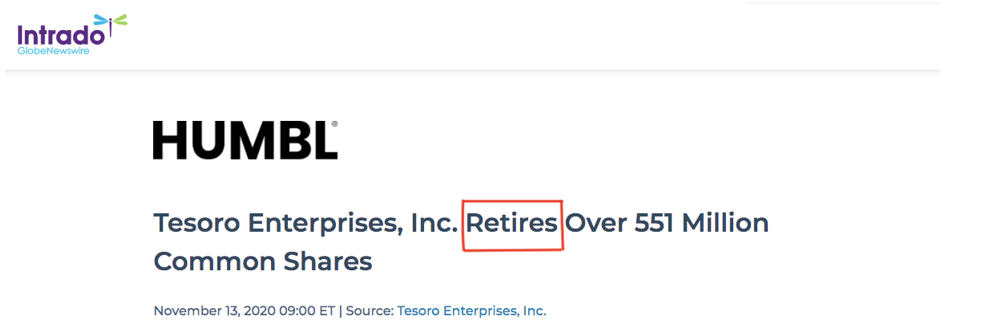
This “good news” of the CEO voluntarily tightening the share count sent HUMBL shares spiking 91% from the prior day.
Four days later, on November 17, the company announced that Foote had locked up an additional 318 million shares, yet again signaling that the CEO was actively removing shares from the overall share count.
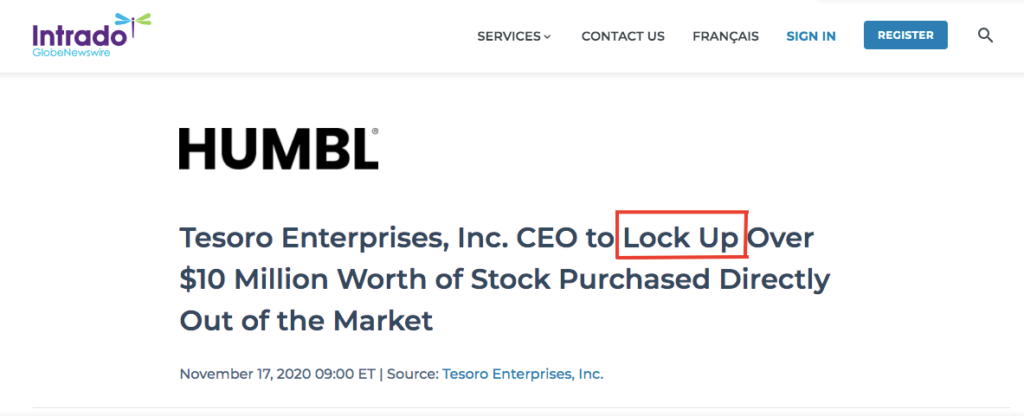
The press release tallied the total reduction in shares, reiterating the notion that Foote was focused on constraining the share count:
“Upon completion of the conversion, Tesoro’s issued and outstanding number of common shares will have been reduced by over 860 million shares since Mr. Foote became President of Tesoro.”
It also included this reassuring statement, highlighting the expectation that there would be no new shares outstanding in 2021, an assertion that would later prove highly misleading:
“The company does not anticipate that the number of common shares outstanding will increase during the remainder of 2020 and throughout 2021.”
HUMBL’s Fully Diluted Market Valuation Hit $50 Billion At One Point, (Greater Than The Market Cap of Twitter) Without Its Regular Shareholders Even Realizing
On February 25th, The Company Announced A Reverse Split. Rather Than Taking the Opportunity to Inform Investors About Its Billions of Shares of Latent Dilution, Promoter George Sharp Told Investors “If You’re Worried About Dilution, Don’t Be”.
By early February, HUMBL’s stock soared to highs of $7.72 as the broader market rallied along with everything crypto. Its investors still had no idea that its fully diluted market cap had just reached ~$50 billion, putting it on par with Twitter.
On February 25, HUMBL announced that FINRA had processed its planned corporate actions including its share issuances and a 4-to-1 reverse stock split.
In the press release, HUMBL COO Jeffrey Hinshaw said one of the reasons for the move was to “pinpoint the true value of the common shares”. Yet at the time, HUMBL did not provide specifics on its massively dilutive preferred shares, making such precision impossible.
The next day, promoter George Sharp fielded questions from concerned shareholders about the corporate action, assuaging those who were concerned about potential dilution: “If you’re worried about dilution, don’t be.” [9:30]
On the same call, Sharp told investors he was simply doing them a favor by being opaque about the company’s corporate actions, such as the surprise reverse stock split announced at the same time:
“I made the conscious decision that we were not going to tell you and I’ll tell you why: it would have created mass panic…I don’t want to sound like I’m your mother, but we saved a lot of you from yourselves here.” [9:55]
HUMBL Filed its Annual Report On April 14th, Disclosing For The First Time (And 4 Months After the Deal Closed) That New Preferred Shares Issued to Insiders Can Convert Into Over 5.5 Billion Shares, Beginning December 2021
It wasn’t until April 14 that shareholders learned the details of the reverse-merger.
The company’s delayed annual report revealed that HUMBL outstanding common stock, on a fully diluted basis, had actually increased by more than 600%, from 974 million shares to 6.5 billion shares.
Specifically, HUMBL’s 552,522 Series B Preferred Shares are eligible for conversion at a rate of 10,000-to-1, into 5,525,220,000 shares of common stock, as soon as December 3, 2021. [Pg. 31] That number then increased in the latest quarterly filing by another ~18 million shares to ~5.54 billion total. [Pg. 3]
HUMBL’s long silence around the dilution stood in sharp contrast to the 2 announcements it made in November regarding the reduction of common stock. It also represented a total about-face from its statement that it did not anticipate an increase in common shares outstanding in 2021.
Facing Criticism From Investors on the Dilution Surprise, HUMBL’s CEO Foote Tweeted That He Wouldn’t Sell Any Of His Personal Shares Until The End of 2022
No Assurances Were Made Regarding the Other 3 Billion Shares, Including Those Held By Foote’s Family And Deal Partners
Following the disclosure, HUMBL’s stock price began to drop as some investors wised up to the latent dilution.
In an effort to quell the panic, HUMBL’s CEO responded by tweeting that he would not sell his “personal shares” until the end of 2022.

Foote appeared to be referencing the preferred shares issued to his entity, 30 Block LLC, which holds 2,497,070,000 common shares on an as-converted basis (45% of the total). [Pg. 4]
Foote said nothing, however, about the 335,610,000 shares, on an as-converted basis, held by The Stephen L. and Sandra M. Foote Revocable Trust. [Pg. 5] Based on background checks, Stephen and Sandra appear to be Brian’s parents. The HUMBL holdings in their trust are worth $292 million based on current prices.
There are also no assurances about the other 3,028,130,000 shares that unlock on December 3, either, which represent ~$2.6 billion worth of stock at current market prices. [Pg. 9]
That latent dilution represents a ticking time bomb for a stock that currently trades about $15 million in volume per day.
Promoter Further Gaslights HUMBL Investors By Making Light Of Extraordinary Dilution Risk, Telling Them They Ought To Sell Their Shares If They Really Think Insiders Are Going To Dump Them At Year End
Promoter George Sharp also responded on Twitter to the backlash following HUMBL’s disclosure, telling shareholders to sell if they think 6 billion new shares will suddenly appear.
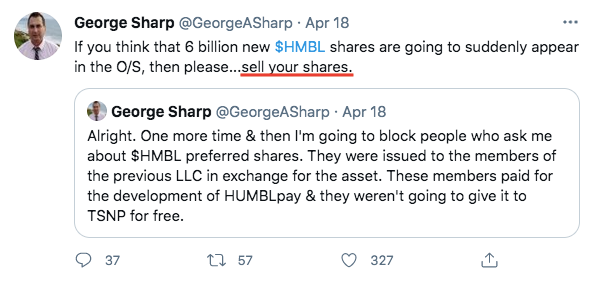
This strikes us as classic gaslighting. To respond to Sharp, about 3 billion shares will suddenly become available for sale in December.
Sharp also chastised investors for not recognizing that insiders had earned these shares. The following individuals now have shares, on an as-converted basis, with the following current valuations:
Brian Foote, CEO of HMBL: $2.2 billion [Pg. 4]
Mark Grado, consultant for HUMBL and Block 30: $488 million [Pg. 5]
Jeffrey Hinshaw, Co-founder and COO of HUMBL: $353 million [Pg.5]
Michele Rivera, Global Partners and Team Lead at HUMBL: $250 million [Pg. 5]
Sharp has done extraordinarily well too. He parlayed his $200,000 investment in HUMBL into an investment valued at around $394 million as of March 9, according to his company Forwardly Inc.’s annual report. [Pg. 20 -21]

Now we examine whether HUMBL’s achievements to date have warranted anything resembling its current valuation.
Part II: HUMBL’s Hollow “Launch”
On April 16, the HUMBL Pay app launched in the US, Canada, Mexico, Australia, Singapore, and New Zealand.
Investors had been hotly anticipating this moment – and perhaps some clarification – since HUMBL’s CEO Brian Foote first described the business with buzzword-laden detail in his earlier December update.
Foote has offered the following descriptions of the business:
- “a mobile app in a limited sandbox”
- “an elastic layer of Web Three that moves seamlessly across borders”
- “a silo-buster” that “curates channels”
- a “Synthetic continuum” that offers “an immersible experience” on a consumer’s “happy path”
Vertical #1—HUMBL Pay App: In A December Investor Call, CEO Foote Explained The Features Built “Right Now”, Which Included Sending And Receiving Money
Halfway through the December call, Foote cut to a slide summarizing all the app’s working features: “O.K. I’m a shareholder. What do you guys have built right now?” [Dec. 9 Call – 25:22]
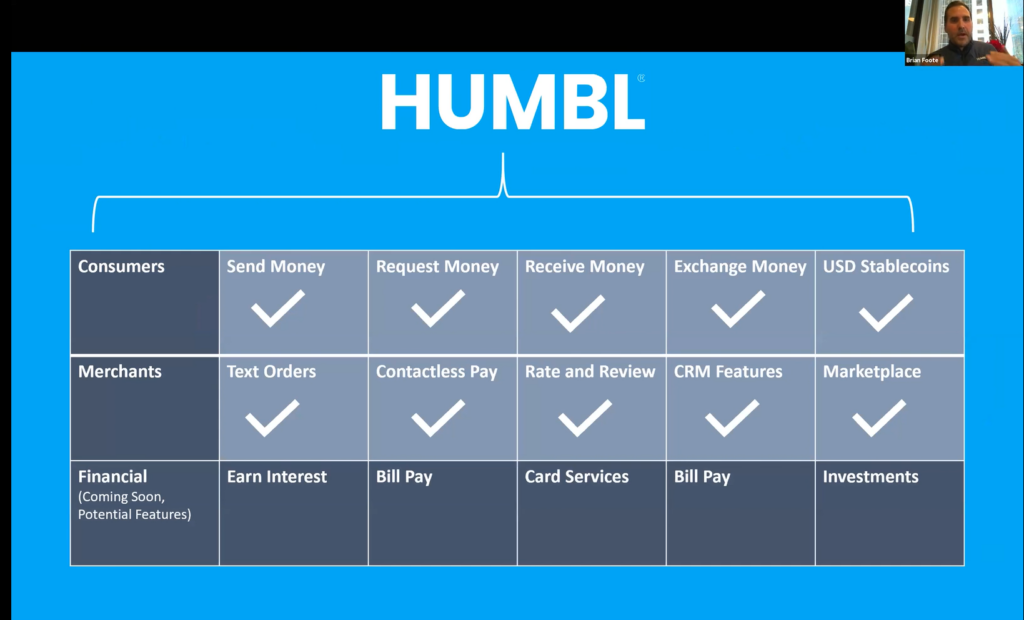
Foote explained:
“Right now, in the barn, we have – send money, request money, receive money, exchange money, stable coins.”
Four Months Later, Those Basic Features Weren’t Functioning At Launch
On April 16, two months behind schedule, HUMBL launched HUMBL Pay, described as “a new way to connect, share and pay around the world.”
Yet we found through our testing that there is no way to send, receive, or request money between users or to even know which users are on the platform.
This becomes clear when attempting to search for the company’s most popular user. Among those helping generate excitement about the HUMBL launch was Nick Carter, former lead member of the 1990s hit boy band The Backstreet Boys.
Carter told his nearly 675,000 Twitter followers that he’d signed up for HUMBL Pay and displayed a screen shot of his username.
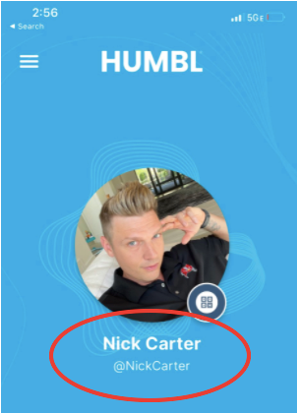
But when we tested the system, we found it didn’t recognize individual users – not even Nick Carter.

Futhermore, there is no indication that users can do anything with stablecoins. All told, the consumer features that Foote claimed to be functional 4 months earlier don’t seem to work.

Despite The Shortcomings Of The HUMBL Pay App, It Immediately Received Rave Reviews On The Apple Store, Suggesting Attempts To Alter Perceptions About The Launch
The Number of New Reviews Has Tapered Off to Nearly Zero, Indicating a Sharp Drop-Off In Interest
One would expect that buzz around a popular ‘paradigm shifting’ app would lead to an increase in users, popularity, and reviews over time.
Given the limitations of HUMBL Pay, the company seems to have experienced the opposite. The app had a few days of rave reviews followed by a complete collapse, trickling off to zero new reviews less than 2 weeks after launch.
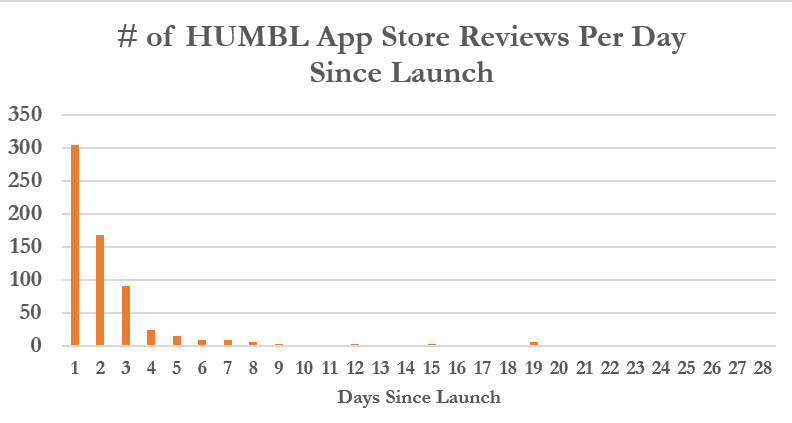
Additionally, despite the lack of functioning features, a flood of 5-star reviews posted to the Apple Store didn’t line up with reality, suggesting a concerted effort to alter perceptions around the app and its launch.
A typical review praised the app’s ability to “send money back and forth between family and friends” – something HUMBL Pay clearly couldn’t do.

Another reviewer claimed to be deleting PayPal, Venmo, and Etsy as HUMBL does everything those apps do – another blatantly untrue statement.

We Sampled Merchants Listed On the App And Found That Only About 5% Were Set Up To Take Payments
Several We Spoke With Didn’t Know How They Got Listed On The Platform
HUMBL also launched features for merchants. The press release announcing the launch of HUMBL Pay explained that users would be able to “discover merchants; as well as pay, tip, rate and review those same merchants in contactless transactions.”
But Step 1, discovering merchants, was a problem. Almost all of the merchants appeared to be in San Diego or NYC. And, searches for a region, say NYC, pulled up inaccurate listings, including merchants in Kansas City and Detroit.
Even after successfully locating a merchant on the system, we found there’s a good chance they don’t accept HUMBL. We reviewed 200 merchant listings on HUMBL Pay and found just 9 merchants out of those 200 who were identified as taking payments via the app.
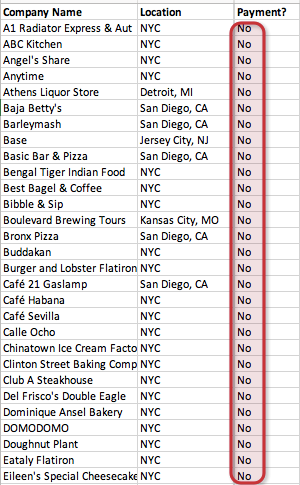
Partial List of merchants downloaded from the HUMBL Pay app
We called numerous HUMBL Pay-listed merchants to ask if they take HUMBL payments. Here’s what a sample told us:
- Doughnut Plant, NYC: “Never heard of it.” “We use Level Up.”
- Barleymash, San Diego: “I doubt we take it because I’ve never heard of it.”
- Los Tacos No. 1, NYC: “We take Apple Pay and Samsung Pay – that’s it.”
- A salesman at Hudson Toyota in Jersey City said he’d need to run it by his manager and called back to explain: “We looked into it and they allow customers to pay with crypto currencies so we wouldn’t be able to accept it.”
So how did all these businesses end up on the platform?
On the day of the launch, Foote had posted on Twitter, encouraging people to “populate” the app with “ratings, reviews, installs.”

As a result, HUMBL Pay may have been populated with hundreds or even thousands of merchants who didn’t enter their own information into the app and don’t even know what it is.
In HUMBL’s Q1 filing, the company stated that it had 13,000 “merchant accounts” on its platform. It appears the company is including in that metric vast numbers of merchants who have never heard of the company let alone use its payment services. [P. 39]
When we reached out to one of the 9 merchants actually accepting HUMBL payments — Derrick’s Personalized Exercise in the NYC area — Derrick told us that he already accepted PayPal and credit cards. He said he added HUMBL Pay because he is a HUMBL shareholder: “I thought I’d go all in.”
All told, organic actual demand seems rather thin.
Vertical #2—HUMBL Marketplace: There are Only 23 Merchants On HUMBL’s Shopify-Like Service
One We Spoke With Gave A Glowing Review, But When We Asked If He Was Compensated To Promote HUMBL He Declined To Answer, Citing An NDA With the Company
HUMBL has a second vertical that it hopes will connect consumers and merchants that it calls HUMBL Marketplace, where merchants can operate an online business and accept online payments for products such as soap, pet beds, and zodiac sign-inspired coffees.
HUMBL Marketplace looks like a preliminary attempt to compete with Shopify and other ecommerce solutions. HUMBL Marketplace has a total of 23 merchants on its platform as of this writing. (By comparison, Shopify reported 1,749,000 merchants using its software at the end of 2020. [Pg. 11])
We called several merchants and successfully connected with Jake Hubenak at The Meat Project. He told us that HUMBL had approached him about putting his barbeque seasoning business on the platform because someone at HUMBL used and liked the products.
Hubenak told us “not a day goes by” when he doesn’t get an order through HUMBL.
It was a glowing endorsement. But, when we asked if he got paid to promote HUMBL, he said he couldn’t talk about that because of a confidentiality agreement.
HUMBL does not disclose whether it pays its merchants to endorse the platform, and a person might reasonably assume that a merchant would not need to be paid to feature his or her products on a selling platform.
Note that FTC rule § 255.5 requires disclosure of compensation for testimonials, yet we saw no disclosure of any endorsement deal.

Despite Claims Of Disrupting The Payments World, HUMBL’s Marketplace Offering Currently Uses Stripe To Process Merchant Payments
We confirmed that the few merchants in the U.S. described as accepting payments – either through HUMBL Pay or HUMBL Marketplace – could actually receive payments.
But the acceptance of such payments doesn’t look to be part of a major disruption to the global payments space. HUMBL discloses on its website that it is not a licensed money transmitter:
“HUMBL, Inc. is not a money services business and does not hold itself out to be such. All money transmission services are being provided exclusively by third parties…HUMBL does not offer money transmission services.”
Instead, a review of HUMBL’s merchant contract shows that transactions are actually being done behind-the-scenes by Stripe, one of the largest online payment processors in the world, who would reasonably be assumed to be a competitor of HUMBL.
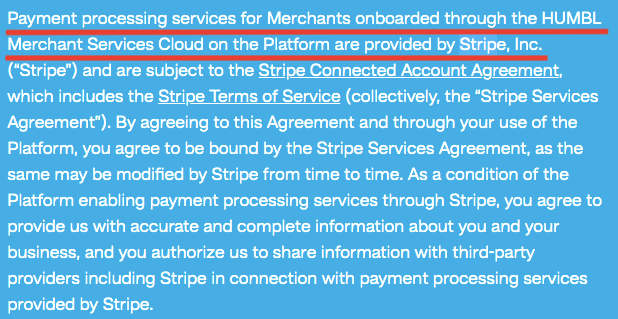
Vertical #3—HUMBL Financial: Complex Setup and Reliance on Third-Party Exchanges
Beyond HUMBL Pay and HUMBL Marketplace, the final piece of the HUMBL enterprise is HUMBL Financial:
“HUMBL Financial™ created its BLOCK ETX products to simplify digital asset investing for customers and institutions seeking exposure to a new, 24/7 digital asset class.”
The vertical generated $2,156 in revenue as of last quarter. (Numbers not in thousands) [Pg. 38]
While the company aims to simplify investing in digital assets, we created an account and experienced the opposite. To access HUMBL’s crypto index products, users need to go through a convoluted process.
First, users need to purchase a license key. Then, HUMBL requires users to grant the app access to the user’s account already set up at an established exchange like Binance, Coinbase Pro, or Bittrex.
From there, users can invest in “index products” through the pre-existing exchange architecture. Index products are baskets of cryptocurrencies that are periodically rebalanced. HUMBL charges $5/month for the service.
Users on social media complained about the process, finding it confusing:

It seems clear that the features are preliminary and that HUMBL lacks the proprietary development-base to truly offer a seamless, integrated product.
HUMBL Claims That The App Uses 20,000 Lines Of Proprietary Code To Create Its Trading Strategies
Yet The “Strategies” Appear To Involve Simple Crypto Positions, Then Periodically Rebalancing Them
HUMBL claims it uses “over 20,000” lines of proprietary code to create crypto trading strategies for its users.
Yet many of the trading strategies offered by HUMBL appear quite simple. For instance, the Block 3 product had just purchased a portfolio of 50% BTC, 25% ETH, and 25% of Litecoin when we signed up for it. Later, the allocation shifted to 50% BTC, 25% Litecoin, and 25% DigiByte.

We don’t think a simple product is a bad thing, but it is unclear how thousands of lines of code factor into optimizing such a portfolio and what would justify the $5/month fee.
PART III: HUMBL’s Vanishing International Deals
A key part of HUMBL’s perceived credibility is its claim to be making meaningful inroads as a payments business operating in markets around the world. According to CEO Brian Foote:
“The 375 million people using Apple Pay are not the total addressable market. HUMBL was built to serve the other 7 billion global consumers for whom the cost, use, and movement of money is on a very different grid.”
HUMBL Says It Got 300 Mexican Merchants Sign Up In The First 3 Days Of Its Launch
Months Later We Found Zero Activity
On the company’s first call with investors back in December, Foote explained that one reason HUMBL is based in San Diego is its proximity to Mexico:
“Part of the reason our business was born here is the majority of merchants in Mexico are in cash still, like so physical paper bills and coins.”
At the time, Foote said the company was surprised by the strong demand for the app among merchants in Mexico:
“I challenged our Mexico sales team. I said ‘OK. Go sign up 100 merchants in a week.’ They came back with 300 merchants in three days.” [Dec. 9, 2020 call, 26:00]
Five months later, however, we couldn’t find anywhere near 300 merchants on HUMBL Pay in Mexico.
Using the map feature, we located 19 merchants in total and identified 2 as accepting HUMBL payments. We reached out to ask about the app:
- Villa Café in Baja: We were told that they had the HUMBL system but had not yet been trained on it.
- Nicky’s Fish and Chips in Iztapalapa, Mexico City: An employee told us they had never heard of HUMBL but that the restaurant accepted credit cards.
“Borderless Day In Baja” Promotional Video Vanishes From HUMBL Website; Mexico Merchant Says Everything Is On Hold
On December 1st, HUMBL announced a successful pilot with merchants in Mexico. The release quoted a tour operator named Fernando Cuevas:
“HUMBL® instantly makes life easier for me, my business and my customers here in Mexico. Being able to pay people for goods and services digitally with HUMBL®, enables my customers to spend more time enjoying their trips, and less time seeking out ATM’s and cash payment options everywhere we go.”
On December 9th, the company posted a video to its website called “A Borderless Day In Baja” which featured a group of visitors touring Mexico with Cuevas, using HUMBL to pay merchants and transfer money to each other.
The video included a stop for a photo op with a Tijuana donkey named Monica painted with zebra stripes.[1] The owner of the zebra donkey accepted HUMBL, per the video:

A disclaimer at the end of the video stated that “all money transmission services are being provided exclusively by third parties” and that the video contains “live and simulated transactions”.
Those simulations still haven’t turned into reality, it seems, despite Mexico being included as one of the markets in which HUMBL Pay was said to have “launched” on April 16.
We contacted Cuevas via WhatsApp in late April. In addition to being the tour guide in HUMBL’s video, Cuevas was also named HUMBL’s “lead affiliate sales representative in the region”. He indicated that the app isn’t ready, writing that until modifications are made to the app, no merchants in Mexico will be able to use it. He then quickly deleted the messages and told us he couldn’t speak on the matter further.
An employee at the Hilo Negro winery and wine bar that featured in the closing segments of the promo video told us they accepted a variety of international and Mexican payment methods but not HUMBL:
“We only use Visa, Mastercard, Carnet (a Mexican transactions service) and also Samsung Pay…No, no we don´t use that one (HUMBL).”
The “Borderless Day In Baja” video has been removed from HUMBL’s website, though it can still be found on Vimeo.
All told, we found no sign that HUMBL is revolutionizing business in Mexico. We think the company should clarify how many active merchants in Mexico have used the app and the total transaction volume to date.
HUMBL CEO Called Deal With India-Based Payment Processor DIPL A Chance “To Work For 1.4 Billion India Customers”
More Than a Year Later, A Deal Partner Says The HUMBL Partnership Was Quashed By COVID And That Economics May Be Impossible
On March 20, 2020, HUMBL announced a deal with Digital India Payments (DIPL), a company that processes payments for 30,000 merchants in India, Nepal, Bangladesh, Maldives, Myanmar and Sri Lanka.
A successful entry into the India market would have been a massive stepping stone toward HUMBL´s stated ambition of serving “7 billion global consumers”.
Foote was quoted as saying:
“We look forward to putting HUMBL technologies to work for 1.4 billion India customers alongside (DIPL).”
The ambitious plan involved providing DIPL’s merchants with software to enable banking and other services for its customers:
“HUMBL Hubs will be offering walk-in services to customers, such as cash pickup, foreign exchange, fair lending, bill payments, pre-paid cards, store credits, travel bookings, internet and cell phone minutes from local merchant (“agent”) locations”
We spoke with Nayan Raut, the managing director of Kloden Technologies, who was the consultant for DIPL in negotiations with HUMBL and was listed as the contact in the press release announcing the deal. He told us that the partnership never went ahead, primarily because DIPL´s agent network largely shut down due to the pandemic.
He noted there were longer term issues, explaining that government regulations in India do not allow a payment platform to charge merchants or consumers any percentage, hampering HUMBL’s planned business model.
“As a consumer, however much I pay the merchant, the same amount goes into his bank account. In terms of digital payments there is 0% MDR (Merchant Discount Rate). That is so (the government) can push digitalization.”
Describing DIPL as a start-up, Raut said he believed DIPL may collapse, along with the deal, as a result of India´s COVID crisis.
“I´m a little worried about DIPL. If they don´t have business for a year or so it will be very difficult for them to survive. I don´t know if they will survive.”
In short, it appears that beyond the press release, HUMBL’s India deal didn’t happen, probably won’t happen, and if it somehow did happen, wouldn’t make HUMBL any money due to regulatory hurdles.
HUMBL Deal With Nigeria’s One Kiosk Was Billed As “A Powerful Economic Driver” For Small Businesses and Communities
More Than A Year Later, An Executive Says The Deal Never Got Off-The-Ground
On April 3, 2020, HUMBL announced a deal with Laos, Nigeria-based One Kiosk, which brings together merchants and online delivery services.
At the time, One Kiosk’s CEO said his company had seen a boom in online ordering due to COVID-19 and he believed an ability to pair the company’s service with HUMBL’s financial services would be “a powerful economic driver.”
Foote claimed HUMBL would use its platform to help local small businesses compete with larger companies:
“HUMBL helps them get in the game against big box competitors.”
But HUMBL didn’t help get anyone into the game.
We reached out to Olatunbosun Babatunde, One Kiosk’s Chief Technology Officer, to check in on the project. He responded:
“Thank you for reaching out. HUMBL actually reach out to us and they wanted One Kiosk to use their payment system on our platform as a way of entering the African market. But it never went beyond that.”
HUMBL Announced a Landmark Deal To Sell Rights For 15 Oceania Countries for up to $15 Million To An Unnamed Partner
But The Deal Later Collapsed. We Found The Proposed Deal Partner Was An Entity With No Apparent Physical Or Online Presence, Based Out of a Personal Residence
In a letter to shareholders on January 22, 2021, Foote told investors that the company had secured “our first of multiple option payments on the distribution rights deal in [the] Oceania region” with “plans to enter the region with this group”.
According to a filing months later, an Australian entity called Tuigamala Group Pty Ltd (TGP) had paid $600,000 in December for an option to purchase the territory rights, with plans to invest an aggregate $15 million. [Pg. 33] The initial $600,000 payment also granted TGP 12.5 million warrants at $1 each, worth as much as $84 million at HUMBL’s peak.
Given HUMBL’s description of its plans, one might expect TPG to have had a significant foothold in the region, such as a network of merchants or consumers.
But we could find no online or physical evidence of TPG’s existence aside from its filings with the Australian Securities and Investments Commission. The entity was created on September 16, 2019 and is owned by Julius Elisara Tuigamala, per the filings.

The company’s principal place of business appears to be Tuigamala’s house in New Zealand at 37 Claremont Street, Kellyville Ridge NSW 2155.
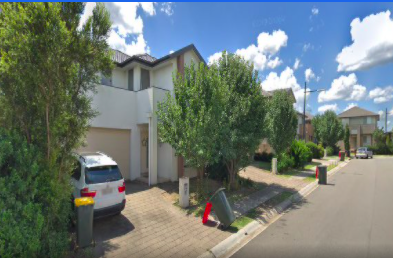
In the end, TGP never made any further payments to purchase the country rights and terminated negotiations, but kept the 12.5 million warrants. [Pg. 33] It is unclear whether TGP has exercised the warrants or sold any stock thus far.
HUMBL Announced a “Strategic Investment” From Singapore’s Cyberbeat, a “1.5 Billion Consumer and Merchant Opportunity”
Cyberbeat Is Less Than 2 Years Old And Has Only Two Listed Employees, Who Received Preferred Shares Valued At $14 Million
Less than two weeks after announcing the reverse merger transaction, HUMBL (then Tesoro) put out a press release detailing a “strategic investment” by Cyberbeat in Singapore.
A HUMBL executive was quoted in the release as saying the company viewed the deal as an “opportunity to establish this global relationship with a proven winner in the Asia Pacific region”, giving the company access to 1.5 billion consumers and merchants.
Local filings show “proven winner” Cyberbeat was incorporated in December 2019:
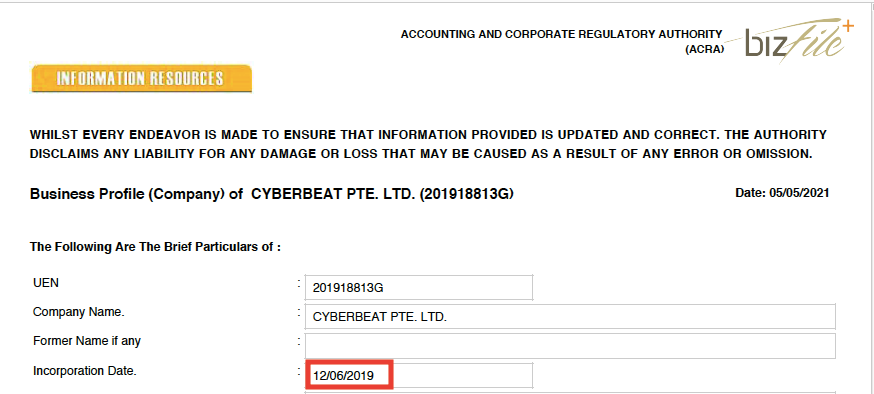
Dinh Thi Hong Hanh and Narayan Rajan Sashi are the only two employees for Cyberbeat listed on LinkedIn. They are also listed as the company’s only two directors in local filings.

The press release didn’t mention how much was actually invested by Cyberbeat, but HUMBL’s annual report showed that Cyberbeat and its two employees/directors received preferred shares convertible into 15,930,000 common shares, currently valued at ~$14 million. [Pg. 7]

Six months after the deal was announced, we have seen no details on specific initiatives resulting from the deal.
In Chile—HUMBL’s Partner is a 1-Year-Old Entity Whose CEO Told Us HUMBL Is Its First Investment of Its Kind.
So Far, The Investment of “Up To” $7.5 Million Has Only Consisted of a $1 Million Purchase of Discounted Stock
On March 16, HUMBL issued a press release announcing its latest international deal, an arrangement with a Chilean entity, the Aurea Group, which could invest “up to” $7.5 million in HUMBL, including $6.5 million for a 35% stake in HUMBL’s future Chilean subsidiary.
The potential business is considered so promising, HUMBL is even offering a limited-edition unisex T-shirt in its swag store to celebrate the yet-to-be-created Chilean business.

So far, all the group has invested in was a discounted block of HUMBL common stock. It paid $1 million for 437,500 shares or $2.29 per share, a 20% discount to the closing price of $2.86 on the date prior to the announcement.
It’s not surprising that investment firm Aurea Group was interested in buying discounted stock. It’s less clear how they’ll provide traction for HUMBL among merchants and consumers in the Chilean market aside from its network of personal relationships.
Aurea Group is new, having been incorporated in March 2020, a year before the HUMBL deal was announced, according to Chilean corporate records. Aurea CEO Juan Pablo Morales told us by phone:
“HUMBL is the first company we have formed an alliance with and we´re looking for more of these companies in order to connect Latin America with the technology from developed markets.”
HUMBL has yet to articulate an actionable strategy for partnering in Chile with a technology or payment company– or any company for that matter. In the press release, HUMBL’s description of where the deal is headed was typically vague:
“HUMBL and Aurea Group are already underway on HUMBL Latin America business development discussions in key verticals such as: banking, merchant and financial services, real estate, hospitality, tourism, sports, festivals, entertainment and ticketing services in the region.”
Aurea Group’s option to make a $6.5 million investment expires at the end of 2021.
Just As We Were Preparing to Publish, George Sharp Exited Stage Left And Blamed Others For The Company’s Performance Decline
Just as we were getting ready to publish, a not-so-unexpected chain of events occurred.
Promoter George Sharp, who had been taking heat on Twitter for HUMBL’s falling share price, made his Twitter account private.
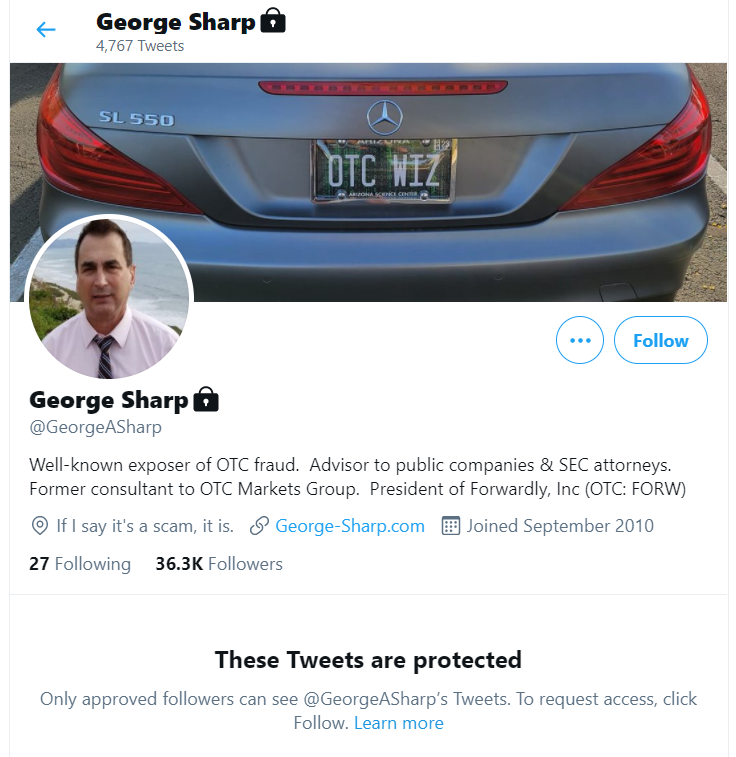
He explained the move was due to “too many smart asses” making “smart ass comments”.

Then, over the weekend, Sharp announced to his private Twitter group that he was parting ways with HUMBL, blaming certain transactions and announcements over the last nine weeks with which he disagreed.
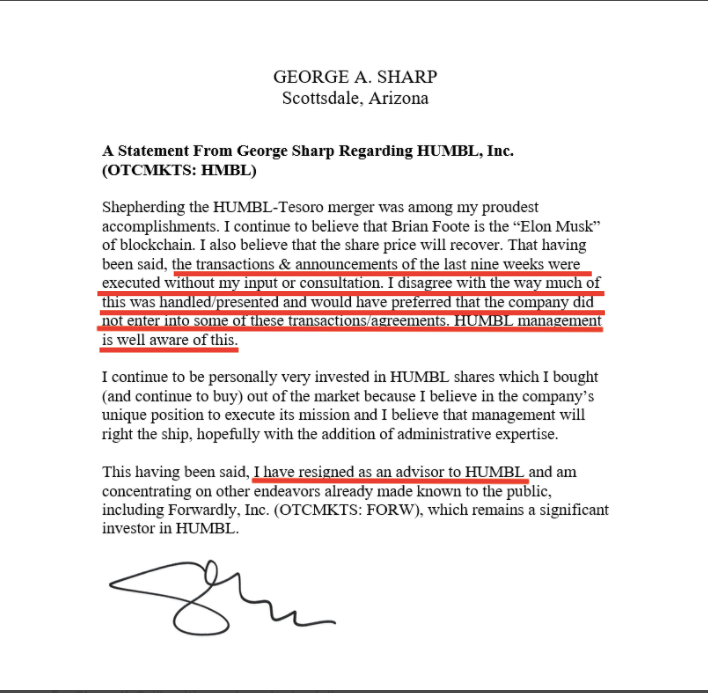
Despite resigning in disagreement, Sharp assured investors that he was still buying shares and that HUMBL’s CEO was still the “Elon Musk of blockchain”.
Conclusion: Investors Are Being Strung Along By Hope, Facing A Tidal Wave of Coming Selling Pressure
Like SPACs, reverse mergers create an avenue for taking companies public quickly and with substandard disclosure requirements. Both have regularly been used to provide opportunities for insiders and early investors to extract wealth from unsuspecting retail investors before those investors realize there’s often little substance to the “business”.
In the past year, such faith-based go-public transactions have brought the investing public an endless parade of risky companies that boast of all the things they will eventually revolutionize.
When presented with the opportunity to prove milestones, these companies often falter, blaming the difficulties of predicting the future.
But HUMBL hasn’t succeeded at implementing features it said were already completed, while talking up evermore speculative and complex lines of business. Its marquee deals, announced loudly as evidence of its legitimacy and progress, have mostly quietly disappeared or stagnated.
Meanwhile, while investors are strung along by hope, and lulled into looking the other way, they face a December reality of literally billions of shares becoming available to convert and sell. We have repeatedly seen how this scenario plays out, and seems to never end well for once-optimistic shareholders. Best of luck to all.
Disclosure: We are short shares of HUMBL, Inc. (OTC:HMBL)
Legal Disclaimer
Use of Hindenburg Research’s research is at your own risk. In no event should Hindenburg Research or any affiliated party be liable for any direct or indirect trading losses caused by any information in this report. You further agree to do your own research and due diligence, consult your own financial, legal, and tax advisors before making any investment decision with respect to transacting in any securities covered herein. You should assume that as of the publication date of any short-biased report or letter, Hindenburg Research (possibly along with or through our members, partners, affiliates, employees, and/or consultants) along with our clients and/or investors has a short position in all stocks (and/or options of the stock) covered herein, and therefore stands to realize significant gains in the event that the price of any stock covered herein declines. Following publication of any report or letter, we intend to continue transacting in the securities covered herein, and we may be long, short, or neutral at any time hereafter regardless of our initial recommendation, conclusions, or opinions. This is not an offer to sell or a solicitation of an offer to buy any security, nor shall any security be offered or sold to any person, in any jurisdiction in which such offer would be unlawful under the securities laws of such jurisdiction. Hindenburg Research is not registered as an investment advisor in the United States or have similar registration in any other jurisdiction. To the best of our ability and belief, all information contained herein is accurate and reliable, and has been obtained from public sources we believe to be accurate and reliable, and who are not insiders or connected persons of the stock covered herein or who may otherwise owe any fiduciary duty or duty of confidentiality to the issuer. However, such information is presented “as is,” without warranty of any kind – whether express or implied. Hindenburg Research makes no representation, express or implied, as to the accuracy, timeliness, or completeness of any such information or with regard to the results to be obtained from its use. All expressions of opinion are subject to change without notice, and Hindenburg Research does not undertake to update or supplement this report or any of the information contained herein.
[1] Aka a “zonkey”. (Now you know)
16 thoughts on “HUMBL: Illusions of Grandeur, Collapsing International Deals, And Lurking Dilution”
Comments are closed.

Fuck your opinions
Another worthless hit piece based on shitty research by a company that has a history of trying to drive down the stocks that they’ve shorted..
Piss of idiots
Sounds like I need to double down. You worked way too hard on this report. New Company with Brian FOOTE. He’s working way harder than you know or exemplify. Thanks for the tip your scared.
you bash the company then you make money from it by shorting it you fucking ass hole.
Complete and full of lies, hope you get sued into the deepest bowels of the earth.
Wow! The author of this article is not only obtuse but delusional as well. This was ALMOST a complete waste of time. There were a couple of good call outs but was purposefully/intentionally bias in favor of creating a negative narrative. The goal of this author was not to inform but to persuade its readers though lack of information and deliberately depicting partial facts. Disgusting.
I will archive your well distorted article ,unfortunately you will be totally proven wrong on all counts. This is not coming from a naive retail investor but from an investor that has made millions on upstart companies. Unfortunately for you ,your hit piece articles are really starting to lose credibility even amongst the most novice of investors.
One just needs to google the images of these guys and know immediately whom are we dealing with! Thank you for yet another excellent report.
Elon told me shorting stocks are bad and you are evil.
Humble stonks TO THE MOON!!!!
good expose, especially on “the promoter” ,SEC sleeping on the job
This article is proven to BE full of BIG LIES !!!!!!
PEOPLE THEY WANT YOUR SHARES CHEAP SO THEY CAN INVEST BIG MONEY !!!!!!
THEY SEE THE POTENTIAL AND ARE IN THE BUSINESS OF LEGAL STEALING (FOR NOW).
SELL AT YOUR OWN RISK, BUT THIS COMPANY WORKS HARD AND WILL DESERVE ALL THE SUCESS THEY ACHIEVE !!!!!!!
Looks like your report helped them recover from $0.76 to $1.06 in five trading sessions.
As much as I dislike the Hindenburg research, I agree than HUMBL appears to be a scam.
I would suggest that the next time you guys keep quiet about your short positions, nobody really likes short sellers. You guys never learn???
All the haters in the comments (and there are a LOT!) are probably Humbl management and shareholders.
A great piece of objective research team.
How’s your short doing now?
These guys are scum of the earth. They will ALWAYS be scum of the earth. They don’t know how to make money any other way than load up on a short position and then send out hit pieces. They SUCK at trading and investing. They are losers and they should all end up in hell one day to burn for eternity. These people should have been aborted. The world would be better without them.
You are a worthless piece of ——-. Writing lies so you can scare investors to sell and take their shares and steal the hard working retail investors money. HOLD everyone and let’s show this piece of —— HUMBL is here to stay and lets squeeze the shorts!!! NASDAQ here we come!!!